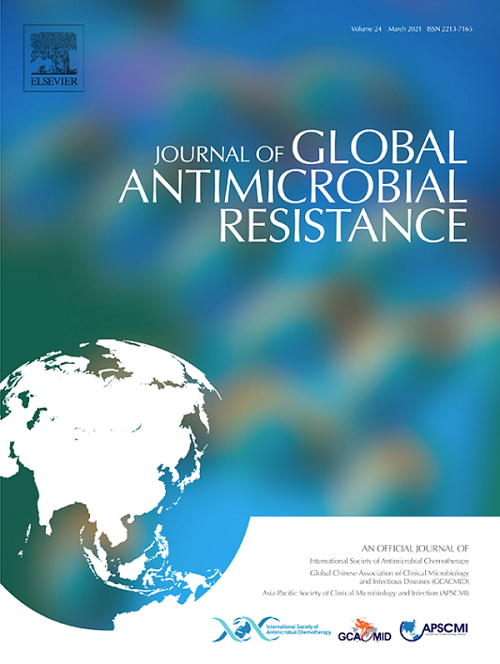Epidemiology, phylogeny and genetic characterization of carbapenem-resistant Citrobacter spp. from 5 hospitals in China
IF 3.7
3区 医学
Q2 INFECTIOUS DISEASES
引用次数: 0
Abstract
Objectives
Carbapenem-resistant Citrobacter spp. (CRC) are increasingly recognized as healthcare-associated pathogens, while systematic studies on clinical epidemiology, genetic diversity, and resistant mechanisms of CRC are relatively scarce. The present study provides comprehensive and systematic research on CRC.
Methods
Clinical isolates of Citrobacter spp. resistant to carbapenems were collected from 5 hospitals across China between October 2014 and December 2017. All the isolates were identified by MALDI-TOF MS and FastANI. Whole-genome sequencing and phylogenetic analyses were performed. Sequencing data were analyzed using MLST, PlasmidFinder, ResFinder, and ISFinder tools.
Results
Thirty-one CRC isolates were isolated from 5 hospitals in different provinces. These strains exhibited significant phylogenetic divergence. ST85 (12.90%) and ST116 (12.90%) were the predominant STs. NDM (41.94%), KPC-2 (25.81%), and IMP (19.35%) were the most frequent carbapenemases of CRC. Interestingly, KPC is frequently associated with C. freundii, while NDM is predominantly observed in C. portucalensis. All the IncX3 and IncN-type plasmids carrying blaNDM and most non-typeplasmids carrying blaKPC were transferrable by conjugation. The genes blaNDM and blaKPC were primarily located within relatively conserved genomic environments, including “ISAba125-blaNDM-bleMBL-trpF-dsbD-cutA1-groES-groEL-ISCR27” and “Tn3 transposase-ISKpn27-blaKPC-2-△ISKpn6-korC-kclA-hp-hp-△repB-TnAS1”.
Conclusions
The clonal transmission of CRC and the conjugative antibiotic resistance plasmids were the key mechanisms driving the spread of multidrug resistance. It highlights the need to strengthen molecular surveillance, with a focus on high-prevalence clones such as ST85 and ST116 carrying mobile resistance elements.
中国5家医院耐碳青霉烯柠檬酸杆菌的流行病学、系统发育及遗传特征
目的:碳青霉烯耐药柠檬酸杆菌(CRC)被越来越多地认为是与医疗保健相关的病原体,但对CRC的临床流行病学、遗传多样性和耐药机制的系统研究相对较少。本研究对结直肠癌进行了全面、系统的研究。方法:收集2014年10月- 2017年12月全国5家医院临床分离的耐碳青霉烯类柠檬酸杆菌菌株。所有菌株均经MALDI-TOF MS和FastANI鉴定。进行全基因组测序和系统发育分析。测序数据分析采用MLST、PlasmidFinder、ResFinder和ISFinder工具。结果:在不同省份的5家医院分离到31株结直肠癌分离株。这些菌株表现出明显的系统发育差异。ST85(12.90%)和ST116(12.90%)是主要的STs。NDM(41.94%)、KPC-2(25.81%)和IMP(19.35%)是结直肠癌中最常见的碳青霉烯酶。有趣的是,KPC通常与C. freundii相关,而NDM主要见于C. portucalensis。所有携带blaNDM的IncX3和incn型质粒以及大多数携带blaKPC的非型质粒均可通过偶联转移。blaNDM和blaKPC基因主要位于相对保守的基因组环境中,包括“isaba125 -blaNDM- blemlb - trpf - dsbd - cuta1 - groes - groel - iscr27”和“Tn3转座酶- iskpn27 -blaKPC-2-△ISKpn6-korC-kclA-hp-hp-△repB-TnAS1”。结论:结直肠癌的克隆传播和结合性耐药质粒是结直肠癌多药耐药传播的关键机制。它强调需要加强分子监测,重点关注携带移动抗性元素的ST85和ST116等高流行克隆。
本文章由计算机程序翻译,如有差异,请以英文原文为准。
求助全文
约1分钟内获得全文
求助全文
来源期刊

Journal of global antimicrobial resistance
INFECTIOUS DISEASES-PHARMACOLOGY & PHARMACY
CiteScore
8.70
自引率
2.20%
发文量
285
审稿时长
34 weeks
期刊介绍:
The Journal of Global Antimicrobial Resistance (JGAR) is a quarterly online journal run by an international Editorial Board that focuses on the global spread of antibiotic-resistant microbes.
JGAR is a dedicated journal for all professionals working in research, health care, the environment and animal infection control, aiming to track the resistance threat worldwide and provides a single voice devoted to antimicrobial resistance (AMR).
Featuring peer-reviewed and up to date research articles, reviews, short notes and hot topics JGAR covers the key topics related to antibacterial, antiviral, antifungal and antiparasitic resistance.
 求助内容:
求助内容: 应助结果提醒方式:
应助结果提醒方式:


